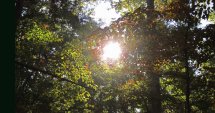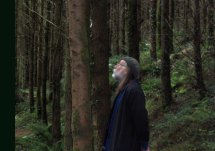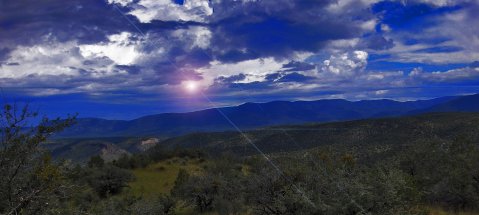I remain in awe of the people who, infected with stealth infections, have refused to give up. They have struggled, often with little help or support, to find their way to health through an illness that, culturally, few understand. I am in awe of their courage and the willingness of so many to go outside the culturally accepted parameters of healing. Some, more than most people know, have turned to plants in that process. And many of those, as their healing has progressed, have, themselves, become people of the plant.
It is often like this when we are called to a new life path. Like so many of those who suffer from stealth pathogens, I found the world of plants over thirty years ago when I became ill and physicians could neither seem to diagnose nor help me. Oddly enough, a local herbalist had just that week introduced me to a plant on the land where I lived, one that was exceptionally good, she said, for intestinal cramping.
What I was experiencing was tremendously debilitating. If the spasms hit away from a couch or bed, I spent a lot of time on the floor. So, in desperation, I dug the root of the plant, carrying it with me, eating pieces of it from time to time. And little by little, the terrible intestinal cramping slowed and finally stopped. I was experiencing an extremely painful form of irritable bowel syndrome, though it would be many years before I understood that. After that initial treatment, the condition remained stable for over twenty years; when it did return, plants once again became my allies in healing, this time alleviating the condition permanently. (The secret? The fresh juices from a large slice of green cabbage and a few fresh plantain leaves from the front yard.)
Illness has a great many functions. It teaches us to be aware, to know ourselves, to understand how the world around us affects us each minute of our lives. It teaches us how to alter the fabric of our lives in order to become whole again . . . and how to remain that way. Illness also teaches us about the darkness that each one of us must face sometime during our lives. In the process, we learn (though all of us would avoid it if we could) how to enter the darkness and endure its touch. We learn about the territory of illness, the depths of depression that often accompany it, and struggle to face our own mortality. We acquire, often slowly and with great resistance, the qualities of character necessary to survive the journey. Personally, I would rather chew tacks. Still . . . all of us must learn, sooner or later, to eat the meal set before us. We learn to eat darkness. . . and eventually, to be unafraid of it. (I don’t remember getting information about all this in the owner’s manual when I was born.) the darkness and endure its touch. We learn about the territory of illness, the depths of depression that often accompany it, and struggle to face our own mortality. We acquire, often slowly and with great resistance, the qualities of character necessary to survive the journey. Personally, I would rather chew tacks. Still . . . all of us must learn, sooner or later, to eat the meal set before us. We learn to eat darkness. . . and eventually, to be unafraid of it. (I don’t remember getting information about all this in the owner’s manual when I was born.)
There are few of us who spend much time in that kind of experience who do not end up, in one form or another, becoming healers sooner or later. I did. For over a decade I was a psychotherapist, then for thirty years an herbalist.
During that time, I have watched the herbal world grow; it’s changed considerably in the process. In those early years, I could buy every herbal book published in any particular year – there weren’t many – and New York publishers produced none of them.
I remember how groundbreaking it was when Christopher Hobbs published his first works on medicinal mushrooms, when Susun Weed first wrote about the Wise Woman Path; I remember hearing David Hoffmann, and Michael Moore, speak for the first time. . . . and Matthew Wood falling asleep while he was teaching. I remember meeting Rosemary Gladstar and her magical Sage Mountain for the first time and Ryan Drum and his seaweed and Pam Montgomery and the Green Nations conferences. And William LaSassier and Keewaydinoquay, too, and so many others.
I knew nearly everyone in the field (one way or another). The good, the bad, and the facially challenged. Now, nearly everyone in the United States has used herbs one time or another; the books published each year are too many to count.
The older generations (nearly all coming of age in the 1960s), many of them my friends, are beginning to pass. New generations are beginning to take their place. Among them, in their thousands, are those from the Lyme world. They know better than most the complexities involved in healing these kinds of chronic infections.
One of the things that the Lyme-group of pathogens teaches those of us who are willing to listen is the sophistication necessary for healing to occur, how much one must listen to the body (our often denigrated and terribly treated best friend without whom we could not exist), how subtly plant medicines work in altering what is happening in our bodies as we struggle toward health. Those from the Lyme world who are becoming herbalists are going to be some of the best healers the herbal world has ever known. I think a lot of people are going to be needing their skills before too long. As for me, unless something very odd happens, this is the last medical herbal I will write. Over the past four years, including this book, I have written five very demanding medical herbals, plus the very long, depth look at the intelligence in Gaian ecosystems (Plant Intelligence and the Imaginal Realm, Inner Traditions, 2013). That latter volume is the final text in a four-book series that includes Sacred Plant Medicine (originally, Roberts Rinehart 1996), The Lost Language of Plants, and The Secret Teachings of Plants (all Inner Traditions, various dates). With its publication, I have finished the work I set out for myself some forty-five years ago. And to be truthful, at age sixty-two I am a bit worn out from the intense work load of the past four years, of the past forty-five years.
One of the primary goals I had set for myself (in writing these medical herbals) was to help bring herbal medicine to the level of sophistication that it is truly capable of. (I think, many of us are going to be needing that sophistication before too long.) I have worked all these years to find a way to create a synthesis between the fundamentally holistic world of plant medicines and that of the reductionistic, mechanicalistic science that has, for far too long, held sway over our conceptions of the world and our practice of medicine. That reductive orientation (as I explore in depth in Plant Intelligence as well as this series of medical herbals) has far outlived its usefulness, especially when it comes to our successful habitation of this planet.
I felt such a synthesis was important because too many people were becoming ill with conditions their physicians could not effectively treat (whether systemic MRSA or chronic diseases caused by stealth pathogens). Such a synthesis, I felt, could help alleviate the uncertainty the many people who needed plant medicines had about herbs, specifically: that they were a superstitious holdover from a more primitive past. I believed that, within such a synthesis, they would be able to feel truths they intuitively knew to be true and, at the same time, experience the kind of analytical approach that they had been told throughout their lives was integral to any legitimate understanding of the world. I have believed for a long time that our capacity to reason does not mean we have to abandon our ability to feel (despite the terror that reductionists have of it). Both are necessary to becoming a full human being, to the practice of medicine, of herbalism, of science. Such a synthesis was also intended to help the physicians who were open-minded enough to begin to overcome the antiplant bias in which they had been trained in medical school. And finally, the things I began to discover as I immersed myself deeper in the work, and which I then wrote of, set a higher bar, for the sophistication that we as herbalists are capable of.
When compared to the many herbal books in print, this series of books is very sophisticated. Yet, future generations of plant people will take this sophistication a great deal further, in directions I can only dimly imagine. (It is crucial that they do so.) These books will become, as so many herbals have throughout the centuries, dated in the extreme.
Nevertheless, to be clear, I believe that the hundreds of thousands of community herbalists that now exist in the United States (ultimately emerging in their present form through the early efforts of Rosemary Gladstar, William LaSassier, and Michael Moore) to be essential. I don’t think we will ever get to the place where we don’t need them. Further, I believe that, as a group, there is no need for them to train in a medical model of disease or use a reductive approach to understanding the dynamics of plant medicines. They fulfill in the United States the same kind of function that barefoot physicians once did in China. They are necessary, in just the form they are currently in. (Attempts to regulate them should be vigorously resisted – those who would regulate them have no one’s best interests at heart, no matter how they present their arguments.) But we do need a more sophisticated body of knowledge, and no, the naturopaths will never provide it. (So, don’t go there.) They don’t, at this time, understand plant medicines all that well. While there are some notable exceptions (a number of whom I know and deeply respect), for the most part, the majority of licensed naturopaths are merely semidoctors, using supplements instead of pharmaceuticals. (This is mostly due to the demands of the accreditation committees that control what naturopathic colleges can teach.) Naturopaths are rarely herbalists, and I doubt, given their desires for licensure (at least the way licensure currently is), they ever will be. Nevertheless, our field is ripe for increasing the sophistication of our knowledge base.
Much still needs to be done; there are so many holes in our herbal knowledge still to be filled. Just off the top of my head, some of them are:
• We need a full and sophisticated look at the dynamics of cancer, whose long-term cytokine dynamics and cellular modulation make many of the Lyme-group’s seem simplistic in comparison. (Most of those currently in print are embarrassingly oversimplified.)
• We need a depth look at the precipitation rates for herbal tinctures; just how fast do the constituents precipitate out of them? If the precipitate is ingested, does it still work medicinally?
• We need a depth exploration of the complex alterations that occur in plant medicine constituents as the plants grow, and especially, as they are picked, dried, and made into medicines. (Begun in a rudimentary way in this series of books, especially, in the analysis of Salvia miltiorrhiza, in the appendix to Natural Treatments for Lyme Coinfections [Inner Traditions, 2015]. )
• We need to further develop the concept of plant synergists.
• The complex impacts that occur during the fermentation of plant medicines on their action as medicinals needs more work. Though it is early days yet, thankfully, some people are starting to make these kinds of medicines. (China is far ahead of us here.)
• We need more work on androgenic plants, especially those that contain testosterone. (Pine pollen certainly isn’t the only one.)
• We need to develop the broad category of organ adaptogens, finding adaptogenic herbs for every organ system. (I think the word “tonic” is not specific enough here.) We have a few: for the heart (hawthorn), for the liver (milk thistle seed), for the endothelial cells (Japanese knotweed), the immune system (Eleutherococcus and several others), and one for cytokines (Salvia miltiorrhiza). We still need some for the kidneys, the lungs, the pancreas – all the organs, big and small. There is at least one herb that is truly adaptogenic for every organ system in the body exists; it is just that no one has been looking all that deeply for them.
• We need an accurate list of the most effective tincture ratios. The approach we have been using (1:5 for the most part) is not, I think, specific enough for our purposes. Someone needs to actually work with every different plant, harvesting it fresh and then drying and weighing it and calculating the appropriate ratios. How much alcohol is really needed, how much water? And what about those that need fats to extract the constituents? Milk or a similar substance is more effective for some of them. What do we do with that truth? (And, no, we do not need to, nor should we, get rid of kitchen herbalism and force all people to make their herbal formulations in a lab.)
• We need to reclaim the sophistication once common to every pharmacist in the United States. In 1900 every pharmacist could prepare a Colchicum tincture and determine the exact amount of colchicine in it. (The National Formularies are filled with similar, very sophisticated techniques of herbal preparation.) There are no longer any pharmacists in the United States that know how do so. The skill base has been lost, abandoned to “progress.” (Most pharmacists are now simply trained as pill dispensers.) It is a skill base that, as herbalists, we need to reclaim.
• We especially need a comprehensive diagnostic system that is uniquely our own, not a modification of a reductive medical approach or the Chinese or the Ayurvedic systems. Most of us in the United States have no real idea of what or who we really are. We don’t spend enough time in other cultures. Our American herbal tradition is primarily a blend of indigenous tribal practices, Thomsonian and Eclectic practice, English traditional medical herbalism, a little bit of European practice from here and there, a bit from the South American, African, and Asian traditions, significant and  unique developments that have occurred since the 1960s, and modern medical approaches. It’s unique. As a people, we just don’t know it. Yet it is out of that syncretic mix that our own diagnostic system must come. As Judy Garland once put it, it’s much better to be a first-rate version of yourself than a second-rate version of someone else. Certainly, the world does not need us to become second-rate medical model, Ayurvedic, or TCM wannabes. unique developments that have occurred since the 1960s, and modern medical approaches. It’s unique. As a people, we just don’t know it. Yet it is out of that syncretic mix that our own diagnostic system must come. As Judy Garland once put it, it’s much better to be a first-rate version of yourself than a second-rate version of someone else. Certainly, the world does not need us to become second-rate medical model, Ayurvedic, or TCM wannabes.
This life I have had – of working with plants as my teachers, my guides, my healing medicines, as living beings whom I have entrusted with my life – has been a rich one. Like most of us, I wandered into it one day without realizing what was going to happen to me. I became part of the long line of human beings who stretch back through time to the first person to whom a plant spoke and insisted it be used for healing. The only profession that moves me more, and has meant more to me, is that of storyteller, the life of a writer. But it was the plants that allowed that part of me expression, that allowed that seed in me to sprout, a seed that has not yet finished its growing.
Those of us who take up the mantle of becoming a plant person only do so for a while. Sooner or later it becomes incumbent on us to pass on to new generations what was passed into us. And that is what I do here. I pass it into you. For many people, I suspect these words will have little meaning. But perhaps you are one of the ones who will hear them differently. If so, do as all people of the plant have done since time began . . . follow the genius inside you, not the maps your culture has given you; listen to the world – it is always speaking to those who would listen – and learn to understand what it’s telling you; remain childlike so you can still ask the simple questions (which are the hardest, but most important, of all to find); seek the answers that you are uniquely meant to find; and find the work that is in you to do. It is in our individual genius, all of us in our millions, that the way through the difficulties of our time will be found; it will never come from the pronouncements of topdown experts (as the stealth pathogens have taught us). Believe me, the journey is worth it.
The Gila Wilderness, 2015. |